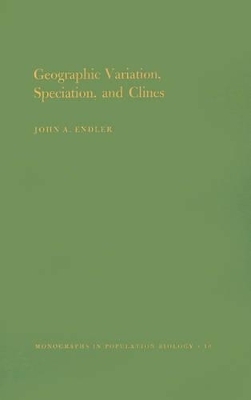
Geographic Variation, Speciation and Clines
Seiten
1977
Princeton University Press (Verlag)
978-0-691-08192-2 (ISBN)
Princeton University Press (Verlag)
978-0-691-08192-2 (ISBN)
- Lieferbar (Termin unbekannt)
- Versandkostenfrei innerhalb Deutschlands
- Auch auf Rechnung
- Verfügbarkeit in der Filiale vor Ort prüfen
- Artikel merken
Explores the origins and development of geographic variation, divergence, and speciation. This work shows how geographic differentiation and speciation may develop in spite of continuous gene flow. It discusses the relationships among gene flow, dispersal, and migration.
Geographic Variation, Speciation and Clines explores the origins and development of geographic variation, divergence, and speciation. In particular it is concerned with genetic divergence as it is usually found on continents, among groups of populations isolated only by distance. Although earlier writers on this topic considered the effects of geography and dispersal, intense geographic differentiation and speciation were thought to require complete isolation. Professor Endler shows how geographic differentiation and speciation may develop in spite of continuous gene flow. Following a review of the diverse and scattered literature on gene flow and population differentiation, the author discusses the relationships among gene flow, dispersal, and migration. He then summarizes the factors which limit the geographic extent of gene flow, and those which allow steep clines to develop in the absence of barriers to gene flow. His analysis draws on examples from the field, experiments, and single- and multiple-locus models. The mechanism and conditions for parapatric speciation are presented: steepening clines, development into hybrid zones, and the evolution of sexual isolation.
In the final chapter the author considers the interpretation of natural clines and the associated geographic patterns of subspecies and species.
Geographic Variation, Speciation and Clines explores the origins and development of geographic variation, divergence, and speciation. In particular it is concerned with genetic divergence as it is usually found on continents, among groups of populations isolated only by distance. Although earlier writers on this topic considered the effects of geography and dispersal, intense geographic differentiation and speciation were thought to require complete isolation. Professor Endler shows how geographic differentiation and speciation may develop in spite of continuous gene flow. Following a review of the diverse and scattered literature on gene flow and population differentiation, the author discusses the relationships among gene flow, dispersal, and migration. He then summarizes the factors which limit the geographic extent of gene flow, and those which allow steep clines to develop in the absence of barriers to gene flow. His analysis draws on examples from the field, experiments, and single- and multiple-locus models. The mechanism and conditions for parapatric speciation are presented: steepening clines, development into hybrid zones, and the evolution of sexual isolation.
In the final chapter the author considers the interpretation of natural clines and the associated geographic patterns of subspecies and species.
| Erscheint lt. Verlag | 21.9.1977 |
|---|---|
| Reihe/Serie | Monographs in Population Biology |
| Verlagsort | New Jersey |
| Sprache | englisch |
| Maße | 140 x 216 mm |
| Gewicht | 312 g |
| Themenwelt | Naturwissenschaften ► Biologie ► Evolution |
| ISBN-10 | 0-691-08192-1 / 0691081921 |
| ISBN-13 | 978-0-691-08192-2 / 9780691081922 |
| Zustand | Neuware |
| Haben Sie eine Frage zum Produkt? |
Mehr entdecken
aus dem Bereich
aus dem Bereich
Komplette Neuübersetzung. Mit einem Nachwort von Josef H. Reichholf.
Buch | Hardcover (2018)
Klett-Cotta (Verlag)
48,00 €
Wie die Vernichtung der Arten unser Überleben bedroht - Der …
Buch | Softcover (2023)
Penguin (Verlag)
15,00 €


